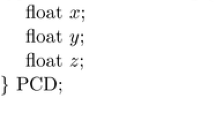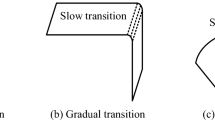Abstract
For the current generation of rapid-prototyping models, laser scanners are currently being used more frequently due to rapid first measuring speed and high precision. Direct generation of an STL file from the digitised points has a great of advantage in that it can reduce time and error during the modelling process. A reduction in the number of point data is important while generating the STL file directly from the measured point data and maintaining precision. A new approach is developed in this paper to generate an STL file directly from point clouds by indicating a tolerance ε to maintain precision. The STL file can be generated directly from scattered points using a new algorithm that reduces and triangulates digitised point data based on triangulation of 3D parametric surfaces. Two experimental examples are presented to demonstrate the effectiveness and efficiency of the proposed algorithm.







Similar content being viewed by others
References
Várady T, Martin RR, Cox J (1997) Reverse engineering of geometric models—an introduction. CAD 19:255–268
Ma W, Kruth JP (1998) NURBS curve and surface fitting for reverse engineering. Int J Adv Manuf Tech 14:918–927
Benkodblac P, Géza K, Várady T, Andor, et al. (2002) Constrained fitting in reverse engineering. CAGD 19:173–205
Várady T, Martin RR, Cox J (2000) Reverse engineering B-rep models from multiple points. In: Proceedings of geometric modeling and processing. IEEE, Hong Kong, April 2000, pp 3–12
Lee KH, Woo H (2000) Direct integration of reverse engineering and rapid prototyping. Comput Ind Eng 38:21–38
Pottmann H, Randrup T (1998) Rotational and helical surface approximation for reverse engineering. Computing 60:307–322
Iishida J (1997) The general B-spline interpolation method and its application to the modification of curves and surfaces. CAD 29:779–790
Ma W, Kruth JP (1995) Parameterization of random measured points for least square fitting of B-spline curves and surfaces. CAD 27:663–675
Burns M (1992) Automated fabrication. Prentice-Hall, Englewood Cliffs
Carleberg P (1994) Product model driven direct manufacturing. In: Proceedings of solid fabrication, pp 270–276
Choi BK, et al. (1988) Triangulation of scattered data in 3D space. CAD 20:239–248
Cline AK, Renka RL (1984) Storage efficient method for construction of a Thiessen triangulation. Rocky Mt J Math 14:119–139
Stroud I, Xirouchakis PC (2000) STL and extensions. Adv Eng Softw 31:83–95
Jurrens KK (1998) Standard for the rapid prototyping. Web RP conference on the future of rapid prototyping.http://www.mcb.co.uk/services/conferen/jun98/forp/
Lee KH, Woo H (2000) Direct integration of reverse engineering and rapid prototyping. Comput Ind Eng 38:21–38
Dutta D, Kumar V, Pratt MJ, Sriram RD (1998) Towards STEP-based data transfer in layered manufacturing. In: Proceedings of 10th international IFIP WG 5.2/5.3 conference prolamat, paper 45, track 2, CD-ROM
Sheng X, Hirsch BE (1992) Triangulation of trimmed surfaces in parametric space. CAD 24:437–444
Filip D, Magedson R, Markot R (1986) Surface algorithm using bounds of derivatives. CAGD 3:295–311
Cuilliëre JC (1998) An adaptive method for the automatic triangulation of 3D parametric surfaces. CAD 30:139–149
Piegl L, Tiller W (1998) Geometry-based triangulation of trimmed NURBS surfaces. CAD 30:11–18
Cuilliëre JC (1998) An adaptive method for the automatic triangulation of 3D parametric surfaces. CAD 30:139–149
Marcum D, Weatherill NP (1995) A procedure for efficient generation of solution adapted unstructured grid. Comput Method Appl M 127:259–268
Field DA (1995) The legacy of automatic mesh generation from solid modeling. CAGD 12:651–673
Nakamoto A, Negami S (2002) Generating triangulations on closed surfaces with minimum degree at least 4. Discrete Math 244:345–349
Floater MS (1997) Parameterization and smooth approximation of surface triangulations. CAGD 14:231–250
Sarkar B, Menq CH (1991) Smooth-surface approximation and reverse engineering. CAD 23:623–628
Peng Q, Loftus M (1998) A new approach to reverse engineering based on vision information. Int J Mach Tool Manuf 38:881–899
Piegl L, Tiller W (1995) The NURBS Book. Springer, Berlin Heidelberg New York
Xing-bo W, Sheng-yi L (2001) Automatic calculation of initial weights for NURBS. ACTA Astronaut 22:184–186
Lee KH, Woo H (2000) Direct integration of reverse engineering and rapid prototyping. Comput Ind Eng 38:21–38
Cohen E, Lyche T, Schumaker LL (1985) Algorithm for degree raising of splines. ACM Trans Graph 4:171–181
Kruth J-P (1998) Reverse engineering modeling of free-form surface from point clouds subject to boundary condition. J Mater Process Tech 76:120–127
Piegl L, Tiller W (2001) Parameterization for surface fitting in reverse engineering. CAD 33:593–603
Newman W, Sproull R (1979) Principles of interactive computer graphics. McGraw-Hill, New York
Preparata FP, Shamos MI (1985) Computational geometry: an introduction. Springer, Berlin Heidelberg New York
Author information
Authors and Affiliations
Corresponding author
Rights and permissions
About this article
Cite this article
Zhongwei, Y., Shouwei, J. STL file generation from digitised data points based on triangulation of 3D parametric surfaces. Int J Adv Manuf Technol 23, 882–888 (2004). https://doi.org/10.1007/s00170-003-1773-0
Received:
Accepted:
Published:
Issue Date:
DOI: https://doi.org/10.1007/s00170-003-1773-0




